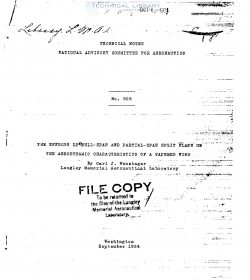naca-tn-505
- Version
- 187 Downloads
- 535.96 KB File Size
- 1 File Count
- November 25, 2016 Create Date
- November 25, 2016 Last Updated
National Advisory Committee for Aeronautics, Technical Notes - The Effects of Full Span and Partial Span Split Flaps on the Aerodynamic Characteristics of a Tapered Wing

The investigation was made to determine the effects
of full—span and of partial—span split flaps on the aero—
dynamic characteristics of a tapered wing. Aerodynamic
force tests were made in the N.A.C.A. 7 by 10 foot wind
tunnel on a highly tapered Clark Y wing equipped with va-
rious split flaps. Two sizes of tapered-chord and two
sizes of constant-chord flaps were tested as full—span
flaps, and a narrow tapered-chord flap was tested as a
partial-span flap by cutting off portions first from the
tip and then from the center.
The investigation showed that with full—span split
flaps the lift and drag characteristics of the tapered
wing up to the stall are similar to those of a rectangu—
lar wing with flaps of comparable size, but that the stall
of the tapered wing with full—span flaps occurs at pro-
gressively lower angles of attack with increasing flap de-
flection up to that for maximum lift.
For partial—span tapered split flaps on a tapered
wing it was found that the maximum lift and the drag at
maximum lift is greater, and the lift-drag ratio at maxi-
mum lift is lese, when the partialuspan flap is located
at the center of the wing than when it is located at the
tip portion. 4
Split trailing-edge flaps are being used to a consid-
erable extent for improving the landing preperties of air—
planes by increasing the maximum lift and also the drag.
Airplanes so equipped are enabled to land more easily in
restricted areas because of their wide range of gliding
angles and because of shorter ground runs. The split
trailing~edge flap is formed by splitting the rear portion I,
of the wing into upper and lower sections and deflecting
the lower section downward for uhe as a flap. This type
of flap may be used over the entire span of the_ wing, or
may haVe portions of the flap near the tip cut off for the
use of lateral control devices,. or it may have a section
cut out at the center'for the fuselage.
| File | Action |
|---|---|
| naca-tn-505 The Effects of Full Span and Partial Span Split Flaps on the Aerodynamic Characteristics of a Tapered Wing.pdf | Download |
Comment On This Post